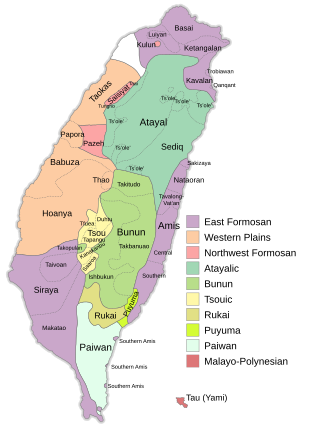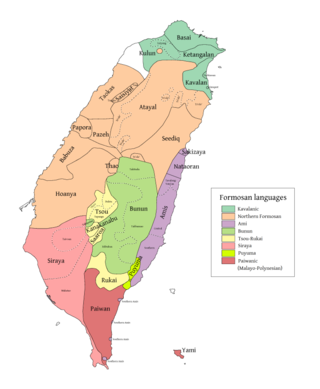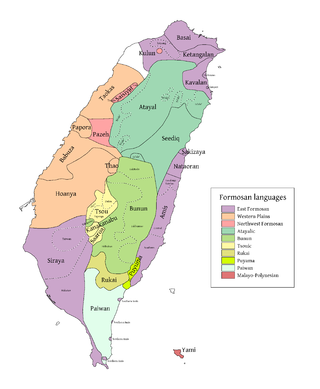
The Austronesian languages are a language family widely spoken throughout Maritime Southeast Asia, parts of Mainland Southeast Asia, Madagascar, the islands of the Pacific Ocean and Taiwan. They are spoken by about 386 million people. This makes it the fifth-largest language family by number of speakers. Major Austronesian languages include Malay, Javanese, Sundanese, Tagalog (Filipino), Malagasy and Cebuano. According to some estimates, the family contains 1,257 languages, which is the second most of any language family.

The Formosan languages are a geographic grouping comprising the languages of the indigenous peoples of Taiwan, all of which are Austronesian. They do not form a single subfamily of Austronesian but rather up to nine separate primary subfamilies. The Taiwanese indigenous peoples recognized by the government are about 2.3% of the island's population. However, only 35% speak their ancestral language, due to centuries of language shift. Of the approximately 26 languages of the Taiwanese indigenous peoples, at least ten are extinct, another four are moribund, and all others are to some degree endangered.

Basay was a Formosan language spoken around modern-day Taipei in northern Taiwan by the Basay, Qauqaut, and Trobiawan peoples. Trobiawan, Linaw, and Qauqaut were other dialects.

Saisiyat is the language of the Saisiyat, a Taiwanese indigenous people. It is a Formosan language of the Austronesian family. It has approximately 4,750 speakers.

Kavalan was formerly spoken in the Northeast coast area of Taiwan by the Kavalan people (噶瑪蘭). It is an East Formosan language of the Austronesian family.

Pazeh and Kaxabu are dialects of an extinct language of the Pazeh and Kaxabu, neighboring Taiwanese indigenous peoples. The language was Formosan, of the Austronesian language family. The last remaining native speaker of the Pazeh dialect died in 2010.

The Qauqaut were a Taiwanese aboriginal people who lived primarily in the town of Su-ao in Yilan County. They spoke the Basay language, which is a Kavalanic language, an Austronesian language family of Taiwan. According to Japanese anthropologist Inō Kanori, the Qauqaut people had been assimilated by the Kavalan people by early 20th century. The Qauqaut people are not recognised by the government of Taiwan.

Siraya is a Formosan language spoken until the end of the 19th century by the indigenous Siraya people of Taiwan, derived from Proto-Siraya. Some scholars believe Taivoan and Makatao are two dialects of Siraya, but now more evidence shows that they should be classified as separate languages.

The Tsouic languages are three Formosan languages, Tsou proper and the Southern languages Kanakanavu and Saaroa. The Southern Tsouic languages of Kanakanavu and Saaroa have the smallest phonemic inventories out of all the Formosan languages, with each language having only 13 consonants and 4 vowels. These two languages are highly endangered, as many Southern Tsouic speakers are shifting to Bunun and Mandarin Chinese.
The Atayalic languages are a group of Formosan languages spoken in northern Taiwan. Robert Blust considers them to form a primary branch within the Austronesian language family, However, Paul Jen-kuei Li groups them into the Northern Formosan branch, which includes the Northwestern Formosan languages.

The Northern Formosan languages is a proposed grouping of Formosan languages that includes the Atayalic languages, the Western Plains languages, and the Northwest Formosan languages.
Sino-Austronesian or Sino-Tibetan-Austronesian is a proposed language family suggested by Laurent Sagart in 1990. Using reconstructions of Old Chinese, Sagart argued that the Austronesian languages are related to the Sinitic languages phonologically, lexically and morphologically. Sagart later accepted the Sino-Tibetan languages as a valid group and extended his proposal to include the rest of Sino-Tibetan. He also placed the Tai–Kadai languages within the Austronesian family as a sister branch of Malayo-Polynesian. The proposal has been largely rejected by other linguists who argue that the similarities between Austronesian and Sino-Tibetan more likely arose from contact rather than being genetic.
This article describes the personal pronoun systems of various Austronesian languages.
Favorlang is an extinct Formosan language closely related to Babuza.
Paul Li, or Li Jen-kuei, is a Taiwanese linguist. Li is a research fellow at the Institute of Linguistics, Academia Sinica in Taipei, Taiwan. Li is a leading specialist on Formosan languages and has published dictionaries on the Pazeh and Kavalan languages.

Luilang, or ambiguously Ketagalan, was a Formosan language spoken south of modern-day Taipei in northern Taiwan by one of several peoples that have been called Ketagalan. The language probably went extinct in the mid-20th century and it is very poorly attested.

Taivoan or Taivuan, is a Formosan language spoken until the end of the 19th century by the indigenous Taivoan people of Taiwan. Taivoan used to be regarded as a dialect of Siraya, but now more evidence has shown that they should be classified as separate languages. The corpora previously regarded as Siraya like the Gospel of St. Matthew and the Notes on Formulary of Christianity translated into "Siraya" by the Dutch people in the 17th century should be in Taivoan majorly.

The Taivoan or Tevorangh are a Taiwanese indigenous people. The Taivoan originally settled around hill and basin areas in Tainan, especially in the Yujing Basin, which the Taivoan called Tamani, later transliterated into Japanese Tamai (玉井) and later borrowed in Chinese (Yujing). The Taivoan historically called themselves Taivoan, Taibowan, Taiburan or Shisha.

Sirayaic languages is one of the sub-branches of the Formosan branch, under the Austronesian languages family. Both Blust (1999) and Li (2010) considers Proto-Siraya belongs to East Formosan languages, along with Kavalanic and Amis languages.








